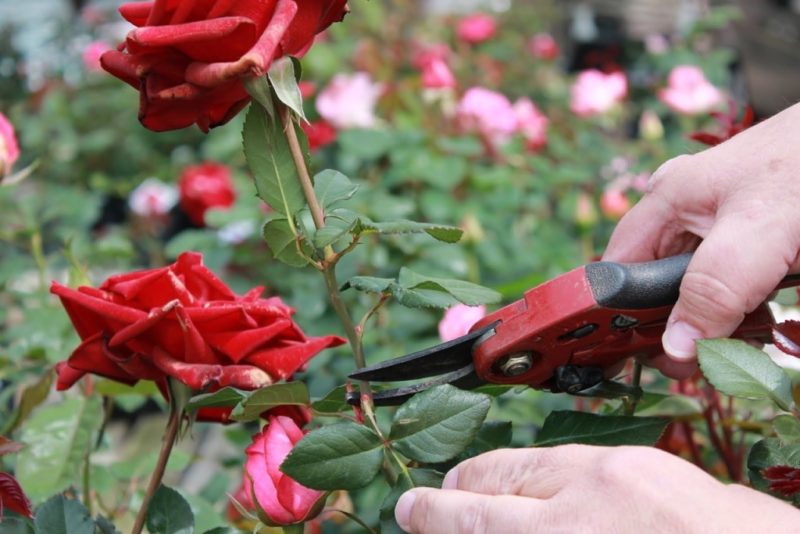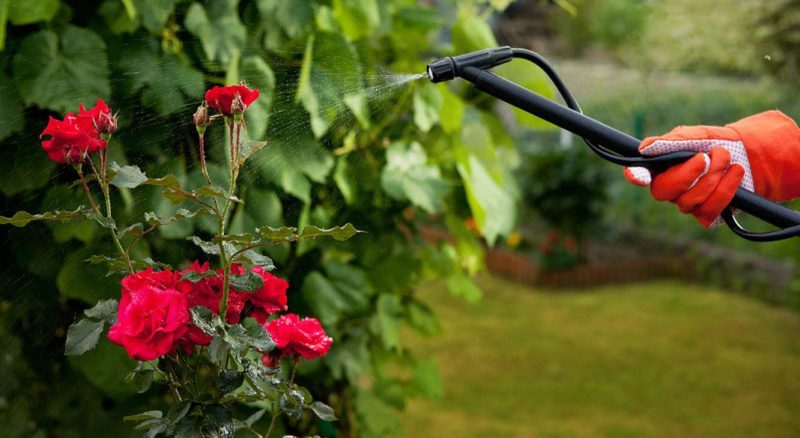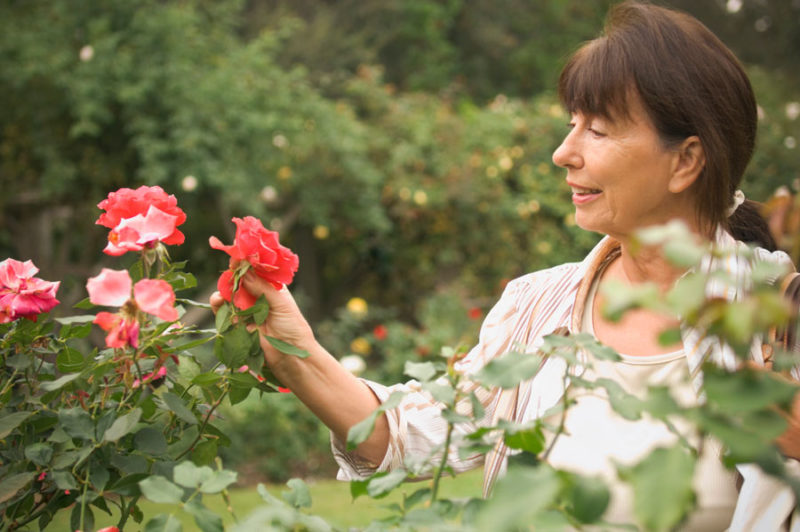We take care of roses in the garden in summer so that they bloom luxuriantly and for a long time
Miniature dwarf rose flowers will decorate small gardens, and lush climbing - arches and gazebos. A beautiful and fragrant rose garden is the dream of every grower. Most varieties begin flowering in June and only finish in August or September. All this time, the rose needs competent care, otherwise there can be no question of beauty and long-term flowering. Consider how to care for roses in your garden in the summer so that they bloom magnificently.
The content of the article
Features of summer rose care
The lush blooming of the rose is the result of timely and competent care. The flower needs regular watering and fertilization, loosening and weeding. Every year, gardeners spend pruningto prevent the development of diseases and pests.
They also pay attention to protective measures - they treat the bushes with fungicides and complex dressings. To achieve the best result, summer residents combine procedures. For example, weeding is carried out together with loosening, and immediately after pruning, the flower is treated to protect against diseases.

Favorable conditions for flowering roses in the garden
In the shade, the rose grows poorly, so it is planted in a sunny area. With a lack of sun and light, diseases arise, the plant withers. It is recommended to choose a place with a low groundwater table, otherwise the high humidity will provoke the development of fungi.
The soil should be fertile with a drainage layer. The recommended acidity level is low or medium.
Another important condition for a favorable flowering is the absence of northern winds and drafts. Rose is a southern flower that does not tolerate sudden changes in weather. When planting, there should be free space between the plants for air microcirculation.
Growing roses too close to each other will lead to disease and insect pests.
How to care for roses for lush bloom
The rose needs proper care throughout the summer. At the beginning of summer, summer residents pay attention to watering and feeding, since July, they carry out prevention of diseases and the appearance of pests.
It is important not to forget about mulching and loosening - these procedures help the roses bloom as quickly as possible.
Watering

Water the plant 2-3 times a month, the abundance depends on the age of the flower. Half a bucket of water is spent on a young bush, and 2 buckets on an adult. If the rose grows on dry and sandy soil, water it more often.
The procedure depends on weather conditions: if the summer is rainy, the number of waterings is reduced. It is recommended to moisten the soil in the evening so that less moisture is lost during evaporation. Since August, the amount of water is reduced to prepare the crop for fall and winter.
Loosening
After each watering, the soil is loosened to a depth of 5-6 cm. This provides oxygen access to the roots, prevents the growth of weeds and the appearance of pests.
Loosening protects the soil from crusting, so water penetrates better to the roots.
They loosen the rose 1-2 times a month, depending on the weather and soil conditions. It is not recommended to deepen the hoe more than 5-6 cm in order not to damage the root system of the plant.
Weeding
Experienced growers combine weeding of a rose garden with loosening. The main goal of the procedure is to protect the flowers from weeds that draw water and nutrients from the ground. For weeding, use a hoe or hoe.
It is recommended to avoid contact of the tool with the stems and not to penetrate deeper than 2-3 cm.
Attention! In the rose garden, annual weeds are often found, which are propagated by seeds, for example, bindweed, quinoa, hogweed. Summer residents are advised to remove them from the site before the formation of seeds. This will help protect the roses in the future.
The optimal time for leaving is dry and calm weather, so that the weeds dry out faster. At high humidity, weeds will provoke the appearance of insect pests.
Mulching
Mulching enriches the soil with nutrients and retains moisture. Mulch protects flower roots from the scorching sun in southern regions.
Before the procedure, gardeners remove weeds and plant debris. As mulch, use ready-made compositions or mowed grass, chips, sawdust, humus.
Compost is especially popular: it nourishes the soil and prolongs the flowering of roses. The thickness of the mulching layer is about 5 cm.
Top dressing
In the summer, flowers need potassium-phosphorus fertilization. They strengthen the immunity of plants, protect them from adverse weather conditions, and nourish the soil.
Phosphorus affects the size of buds and promotes the formation of new roots, while potassium is responsible for frost resistance. Summer residents use ready-made fertilizer "Bona Forte". In addition to trace elements, it contains succinic acid and silicon. Sold in granules, it is convenient and effective to use.
Fertika Kristalon complex feeding is also used. Water-soluble fertilizer increases the color intensity of flowers and leaves, increases the duration of flowering. For watering, 10 ml of the product is dissolved in 10 liters of water, the mixture is added to the root. Some gardeners use the product as a foliar dressing.
Pruning
The rose is pruned regularly, 1-2 times a year. This stimulates the growth of new shoots, protects the shrub from pests. The length of the cut depends on the potential of each flower. If the rose does not grow well, it is recommended to prune it by 15–20 cm. This guarantees the health of the bush and the resumption of development.
Attention! A garden knife and pruner are used for the procedure. Tools must be sanitized and sharp to prevent damage and deformation of the shoots. It is best to wear gloves to avoid getting hurt on the spikes.
The flower is always cut off above the eyes, the cut should be oblique, not even. Otherwise, the rose will take a long time to recover after the procedure. Dry and diseased branches are removed completely. Shoots that have become dark brown are also removed.
Protection against diseases and pests

Protective and preventive measures are required for roses of any age and at every stage of development. Diseases and pests appear for various reasons: due to agricultural errors, excess or lack of moisture, acidic soil, garbage on the site.
To grow a healthy rose garden, gardeners use the following methods:
- Roses are sprayed with fungicide and acaricide "Tiovit Jet". The drug helps to get rid of powdery mildew and sucking insects. The product is sold in granules that are dissolved in water and sprayed over the plant at a distance of 15–20 cm.
- A solution of Bordeaux liquid (1%) helps to get rid of rust. Leaves, shoots and buds are sprayed from a spray bottle in the early morning.
- To protect against septoria, aphids and black spot, a solution based on Topaz is used. Before processing, remove all affected parts of the plant and burn them.
Features of care depending on the type / variety of roses
Roses are divided into climbing, dwarf, hybrid tea.
Climbing They are distinguished by long and developed shoots; they are used to decorate arches, arbors and fences. In caring for them, special attention is paid to pruning: with its help, they give the bush the desired appearance and shape. Pruning is carried out in early spring and late summer. It is recommended to shorten the rose so that the length of one stem is no more than 20 cm. After the procedure, the plant is fed with wood ash to restore strength. Favorite varieties of gardeners are Rosarium Utersen and Elf.
Height dwarf roses does not exceed 40 cm. The bushes are neat and miniature, require good lighting. In the summer, plants must be fed 2-3 times with organic matter (compost, manure, humus) and mineral fertilizers (potassium salt, superphosphate). Popular varieties dwarf roses - Hummingbird, Rosemary, Meidi.
Have tea-hybrid roses compact tall shoots and delicate flowers. To keep them fresh and bloom longer, it is important to water them correctly. Plants do not tolerate drought, but they also do not tolerate excess moisture. After moistening, the roses are mulched with sawdust. Common hybrid tea varieties are Lovely Red, Grand Gala, Polar Star.
Depending on the region of cultivation
In roses in the north, it is important to strengthen the immune system. To do this, use complex dressings that improve metabolism, saturate the earth with vitamins and microelements. A prerequisite for leaving is mulching. A layer of grass or hay will protect the root system from unexpected cold weather or frost.
In the Moscow region and the southern regions, it is recommended to monitor the level of moisture in the soil. Water the flowers in the morning, before sunrise. This simple rule of thumb prevents moisture from evaporating. Summer residents use water at room temperature; on average, 1 bucket takes 1 bush. The amount of moisture is increased if the soil is sandy and dry.
Experienced gardening tips

Before planting stalk roses in indoor or outdoor ground, it is recommended to prepare the soil. It should be light and friable, with neutral or low acidity.
Attention! You can not place the rose garden in areas that are located near swamps or groundwater: in such places, the flower is often sick. This is especially true for the gardens of the Leningrad region, the Urals, Siberia and the middle zone.
It is not recommended to feed the rose more often than once every 2 weeks. An excess of micronutrients is as dangerous as a deficiency. Experienced summer residents are advised to write down when and how much fertilizer was applied. This will help to avoid mistakes in care.
To understand the state of the rose, it is regularly examined. For example, the presence of black spots indicates that the plant lacks potassium and magnesium, and the falling of the petals signals an excess of water. In this case, the soil is loosened and covered with sand.
Conclusion
Proper care of roses in the country, in an open area, has many features. So, every year the plant is pruned to get as many beautiful and fragrant buds as possible. Water the rose garden only with water at room temperature to protect against diseases and pests.
In summer, it is recommended to feed the flowers with mineral complex preparations. If you follow all the recommendations, the buds will turn into fragrant and colorful flowers that will delight you until the end of summer.